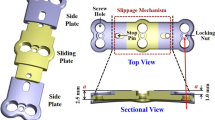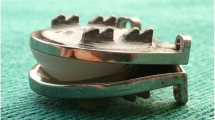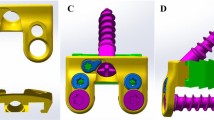Abstract
Purpose and methods
For the treatment of degenerative disc diseases of the cervical spine, anterior cervical discectomy and fusion (ACDF) still represents the standard procedure. However, long term clinical studies have shown a higher incidence of pathologies in the adjacent segments. As an alternative to spinal fusion, cervical total disc replacement (cTDR) or dynamically implants were increasingly used. This in vitro study analyzed the kinematics and intradiscal pressures in seven multi-segmental human cervical spine using hybrid multidirectional test method. The aim of our study was to compare the intact condition with a single-level dynamic stabilization with DCI®, with cTDR (activC®) and with simulated ACDF (CeSPACE® cage and CASPAR plate).
Results
No significant changes in the kinematics and pressures were observed in all segments after arthroplasty. The DCI® significantly decreased the motion of the treated segment in flexion/extension and lateral bending with some remaining residual mobility. Thereby the motion of the upper segment was increased significantly in flexion/extension. No significant changes of the intradiscal pressures were observed. With simulated fusion the motion of the indexed level was significantly decreased in flexion/extension and axial rotation with the greatest changes in the adjacent levels and the highest pressures.
Conclusion
Based on our biomechanical study the DCI® can pose an alternative to fusion, which has a lesser effect on adjacent levels. This might reduce the risk of long-term degeneration in those levels. In particular, the facet joint arthritis and kyphotic deformity, as a contraindication to the arthroplasty, could be a clinical application of the dynamic implant.



Similar content being viewed by others
References
Chang U-K, Kim DH, Lee MC et al (2007) Changes in adjacent-level disc pressure and facet joint force after cervical arthroplasty compared with cervical discectomy and fusion. J Neurosurg Spine 7:33–39. doi:10.3171/SPI-07/07/033
DiAngelo DJ, Foley KT, Morrow BR et al (2004) In vitro biomechanics of cervical disc arthroplasty with the ProDisc-C total disc implant. Neurosurg Focus 17:E7
Ragab AA, Escarcega AJ, Zdeblick TA (2006) A quantitative analysis of strain at adjacent segments after segmental immobilization of the cervical spine. J Spinal Disord Tech 19:407–410
Galbusera F, Bellini CM, Raimondi MT et al (2008) Cervical spine biomechanics following implantation of a disc prosthesis. Med Eng Phys 30:1127–1133. doi:10.1016/j.medengphy.2008.02.002
Goffin J, Geusens E, Vantomme N et al (2004) Long-term follow-up after interbody fusion of the cervical spine. J Spinal Disord Tech 17:79–85
Hilibrand AS, Carlson GD, Palumbo MA et al (1999) Radiculopathy and myelopathy at segments adjacent to site of a previous anterior cervical arthrodesis. J Bone Jt Surg Br 81-A:519–528
Delamarter RB, Zigler J (2013) Five-year reoperation rates, cervical total disc replacement versus fusion, results of a prospective randomized clinical trial. Spine 38:711–717. doi:10.1097/BRS.0b013e3182797592 (Phila Pa 1976)
Blumenthal SL, Ohnmeiss DD, Guyer RD, Zigler JE (2013) Reoperations in cervical total disc replacement compared with anterior cervical fusion: results compiled from multiple prospective food and drug administration investigational device exemption trials conducted at a single site. Spine 38:1177–1182. doi:10.1097/BRS.0b013e31828ce774 (Phila Pa 1976)
Auerbach JD, Jones KJ, Fras CI et al (2008) The prevalence of indications and contraindications to cervical total disc replacement. Spine J 8:711–716. doi:10.1016/j.spinee.2007.06.018
Patwardhan AG, Havey RM, Ghanayem AJ et al (2000) Load-carrying capacity of the human cervical spine in compression is increased under a follower load. Spine 25:1548–1554 (Phila Pa 1976)
Panjabi MM (2007) Hybrid multidirectional test method to evaluate spinal adjacent-level effects. Clin Biomech 22:257–265. doi:10.1016/j.clinbiomech.2006.08.006
Hurschler C, Pott LS, Gossé F, Wirth C (2005) Sensor-guided robot. Spine motion-segment. Biomech. Test. Valid. against pure moment Appar. In: Transactions of the 51st annual meeting of the Orthopedic Research Society
Wilke H, Wenger K, Claes L (1998) Testing criteria for spinal implants: recommendations for the standardization of in vitro stability testing of spinal implants. Eur Spine J 7:148–154
Crawford N, Dickman C (1997) Construction of local vertebral coordinate systems using a digitizing probe: technical note. Spine 22:559–563 (Phila Pa 1976)
White AA III, Panjabi M (1990) Clinical biomechanics of the spine, 2nd edn. J.B. Lippincott Comp, Philadelphia
Patwardhan AG, Tzermiadianos MN, Tsitsopoulos PP et al (2012) Primary and coupled motions after cervical total disc replacement using a compressible six-degree-of-freedom prosthesis. Eur Spine J 21:618–629. doi:10.1007/s00586-010-1575-7
Chang U-K, Kim DH, Lee MC et al (2007) Range of motion change after cervical arthroplasty with ProDisc-C and prestige artificial discs compared with anterior cervical discectomy and fusion. J Neurosurg Spine 7:40–46. doi:10.3171/SPI-07/07/040
McAfee PC, Cunningham B, Dmitriev A et al (2003) Cervical disc replacement-porous coated motion prosthesis: a comparative biomechanical analysis showing the key role of the posterior longitudinal ligament. Spine 28:S176–S185. doi:10.1097/01.BRS.0000092219.28382.0C (Phila Pa 1976)
Suchomel P, Jurák L, Antinheimo J et al (2014) Does sagittal position of the CTDR-related centre of rotation influence functional outcome? Prospective 2-year follow-up analysis. Eur Spine J 23:1124–1134. doi:10.1007/s00586-014-3223-0
Mo ZJ, Bin Zhao Y, Wang LZ et al (2014) Biomechanical effects of cervical arthroplasty with U-shaped disc implant on segmental range of motion and loading of surrounding soft tissue. Eur Spine J 23:613–621. doi:10.1007/s00586-013-3070-4
Wang L, Song YM, Liu LM et al (2014) Clinical and radiographic outcomes of dynamic cervical implant replacement for treatment of single-level degenerative cervical disc disease: a 24-month follow-up. Eur Spine J 23:1680–1687. doi:10.1007/s00586-014-3180-7
Matgé G, Berthold C, Gunness VRN et al (2015) Stabilization with the dynamic cervical implant: a novel treatment approach following cervical discectomy and decompression. J Neurosurg Spine 22:237–245. doi:10.3171/2014.10.SPINE131089
Panjabi MM (1988) Biomechanical evaluation of spinal fixation devices: I. A conceptual framework. Spine 13:1129–1134 (Phila Pa 1976)
Crawford NR (2007) Does the “hybrid multidirectional test method” generate quality data or paradoxical data? Clin Biomech (Bristol, Avon) 22:861–2; author reply 863–4. doi: 10.1016/j.clinbiomech.2007.04.005
Panjabi M (2007) Reply. Clin Biomech 22:863–864. doi:10.1016/j.clinbiomech.2007.04.001
Dreischarf M, Zander T, Bergmann G, Rohlmann A (2010) A non-optimized follower load path may cause considerable intervertebral rotations. J Biomech 43:2625–2628. doi:10.1016/j.jbiomech.2010.05.033
Herdmann J, Buddenberg P, Pilz A et al (2011) Life quality after cervical reconstruction with dynamic cervical implant. Eur Spine J, Springer, p 2026
Li Z, Yu S, Zhao Y et al (2014) Clinical and radiologic comparison of dynamic cervical implant arthroplasty versus anterior cervical discectomy and fusion for the treatment of cervical degenerative disc disease. J Clin Neurosci 21:942–948. doi:10.1016/j.jocn.2013.09.007
Acknowledgments
This study was funded by the Paradigm Spine GmbH and in parts by grants of the HiLF program of the Hannover Medical School. Aesculap AG provided the implants for the cTDR and ACDF.
Author information
Authors and Affiliations
Corresponding author
Ethics declarations
Conflict of interest
The corresponding author BW received honoraria for lectures during two workshops of the Paradigm Spine GmbH.
Rights and permissions
About this article
Cite this article
Welke, B., Schwarze, M., Hurschler, C. et al. In vitro investigation of a new dynamic cervical implant: comparison to spinal fusion and total disc replacement. Eur Spine J 25, 2247–2254 (2016). https://doi.org/10.1007/s00586-015-4361-8
Received:
Revised:
Accepted:
Published:
Issue Date:
DOI: https://doi.org/10.1007/s00586-015-4361-8




